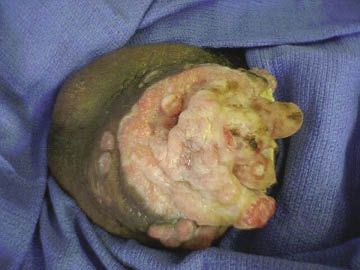- Clinical Technology
- Adult Immunization
- Hepatology
- Pediatric Immunization
- Screening
- Psychiatry
- Allergy
- Women's Health
- Cardiology
- Pediatrics
- Dermatology
- Endocrinology
- Pain Management
- Gastroenterology
- Infectious Disease
- Obesity Medicine
- Rheumatology
- Nephrology
- Neurology
- Pulmonology
What Is This Penile Lesion?
For 20 years, a lesion has been slowly growing on the penis of a 51-year-old man. He has noted bleeding and a foul-smelling discharge from the mass. Recently, the patient experienced a 30-lb weight loss. He has had 5 sex partners in his lifetime but has been monogamous for the past year.

For 20 years, a lesion has been slowly growing on the penis of a 51-year-old man. He has noted bleeding and a foul-smelling discharge from the mass. Recently, the patient experienced a 30-lb weight loss. He has had 5 sex partners in his lifetime but has been monogamous for the past year.
Physical examination reveals firm, fixed inguinal lymph nodes. A urology consultation is obtained, and biopsies are performed. An HIV test is also ordered.
Pending the biopsy results, what do you suspect?
(Answer and discussion on next page.)
Answer: Penile cancer
Tissue examination of the biopsy specimen revealed moderately differentiated invasive squamous cell carcinoma. Positron emission tomography and CT scans showed multiple metastases. The HIV test result was negative.
Prognosis and treatment were discussed with the patient and his family. Hospice was chosen. He died shortly thereafter.
Risk factors for penile cancer include the following1,2:
• Uncircumcised state (penile cancer is very rare in Jewish men).
• Cigarette smoking.
• Human papillomavirus (HPV) infection (polymerase chain reaction studies have demonstrated evidence of viral infection in men with penile cancer).
• Balanitis.
• Phimosis.
Premalignant conditions, such as condylomata, may herald the development of penile cancer.

Select treatments for early-stage disease (carcinoma in situ)-such as 5-fluorouracil, topical interferon, and photodynamic therapy-have been beneficial. A helpful rule in primary care is to obtain a biopsy for all penile lesions that raise suspicion of malignancy as well as all lesions initially considered to be infectious that do not respond to antibiotics. If the diagnosis is made earlier in men with condylomata or other premalignant lesions, the prognosis is better.
Since the growth pattern of this patient’s tumor was indolent (enlarging over 20 years), the mass was initially thought to have been a genital condyloma consequent to HPV infection. Histopathological examination confirmed this suspicion. Inspection of the excised tissue under microscopy revealed marked koilocytic (ballooning) changes in penile squamous cells, which identified this patient’s lesion as the “warty,” or condylomatous, tissue subtype. This subtype is slow-growing and cauliflower-like in appearance; it is associated with HPV infection and accounts for about 10% of all penile carcinomas. It may be distinguished from papillary carcinoma (another important subtype) by the presence of koilocytes.3 The prognosis for patients who have such tumors is generally good-if the lesions are discovered early.
References:
REFERENCES:
1.
Minhas S, Manseck A, Watya S, Hegarty PK. Penile cancer-prevention and premalignant conditions.
Urology.
2010;76:(2 suppl 1):S24-S35.
2.
Pow-Sang MR, Ferreira U, Pow-Sang JM, et al. Epidemiology and natural history of penile cancer.
Urology.
2010;76:(2 suppl 1):S2-S6.
3.
Chaux A, Velazquez EF, Algaba F, et al. Developments in the pathology of penile squamous cell carcinomas.
Urology.
2010;76(2 suppl 1):S7-S14.
